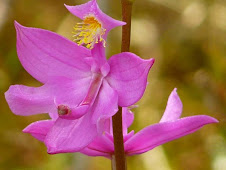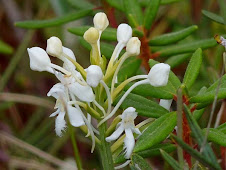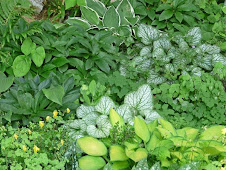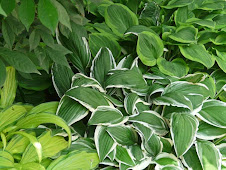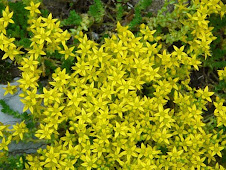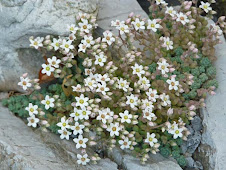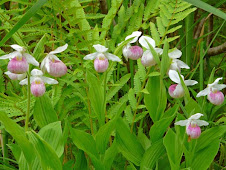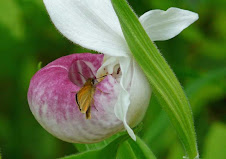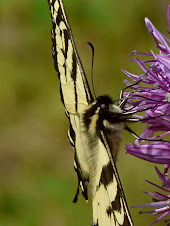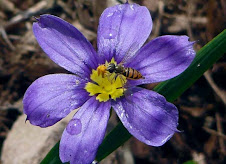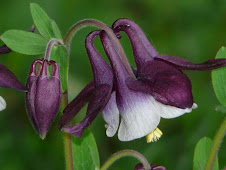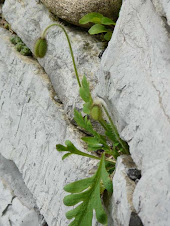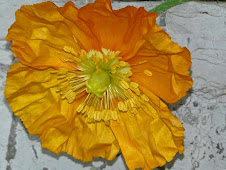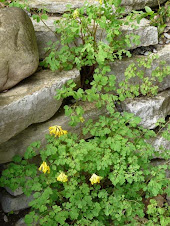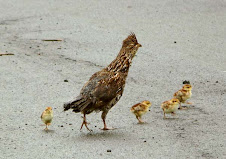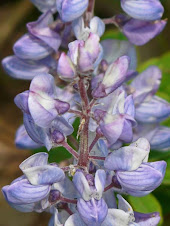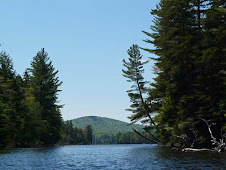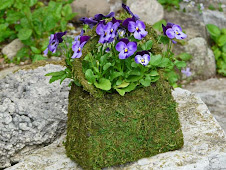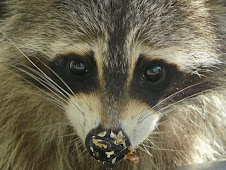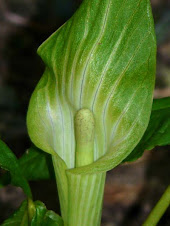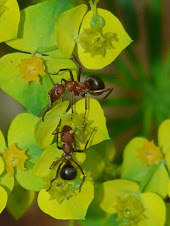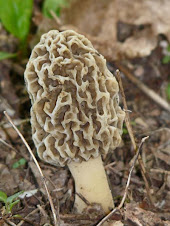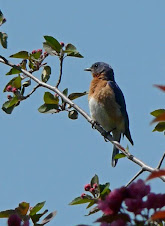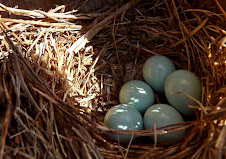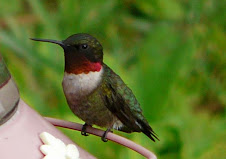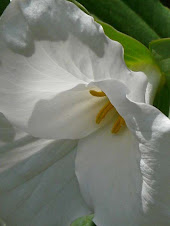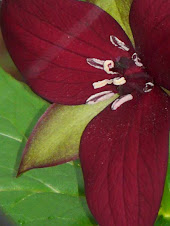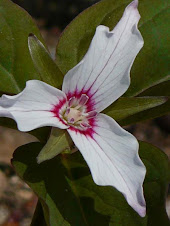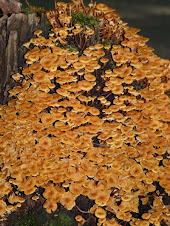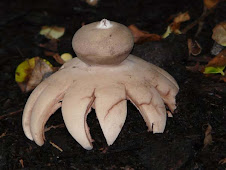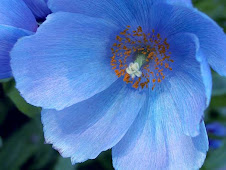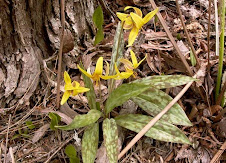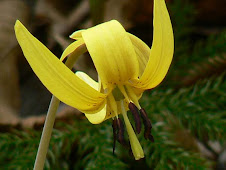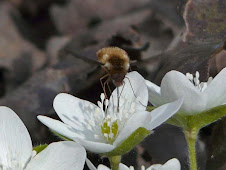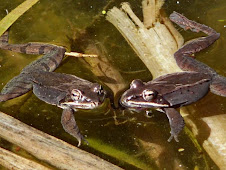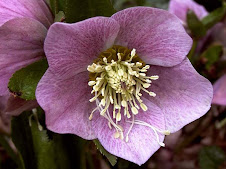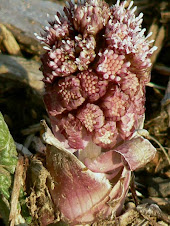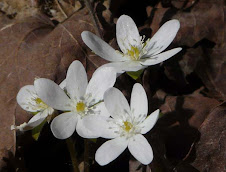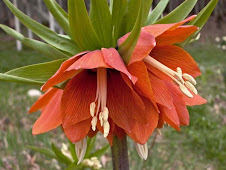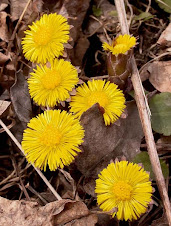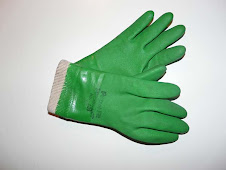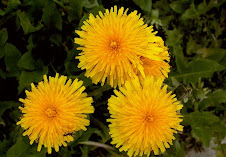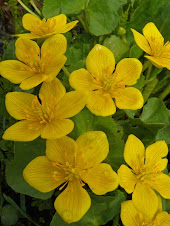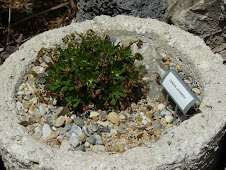I shall be gone for a few days, I am off to the Philadelphia Flower Show. The orchid photo was taken at last year's show. So were the alpine plants in the trough. More about Alpine Plants, Rock Gardening and Container planting when I return.
Think SPRING!!!!
Saturday, February 28, 2009
Friday, February 27, 2009
For Love of Onions...
I am in the process of checking with the manufacturer of my, "secret weapon", that keeps deer from devouring my plants, in order to share it with you.
Actually last year I was able to observe the entire progress of my many Hosta Plants. Normally, they break through the ground and begin the growing process in mid Spring, become mature, luscious plants in Summer and turn a multitude of hues in Fall. Before I discovered the "secret weapon", my Hosta plants emerged and become meals for the hungry "deerly beloved". The stems and maybe a few bedraggled leaves were all that was left for this gardener's enjoyment.
I needed to turn my attention to some other plants, that would not be immediately sought out as "food". In addition to the prickly, poisonous, green-gray smelly plants in my garden, I also added many bulbs. Daffodil, crocus, crown imperial, and onions are some of my choices. Especially onions or Alliums. Allium 'Globemaster' and 'Shubertii' are my favorites. The Globemasters start out as glorious green stars lying on the ground. Soon the bud emerges and the stem pushes upward until it reaches about 3 feet. The bud enlarges and bursts into an enormous orb of lavender florescence. When the flowers are spent, after several weeks, I remove the stem and dry the flowers for an Autumn and Winter floral arrangement. Shubertii is not as tall, but the orb is basketball size and when dried and arranged, look like a bouquet of fireworks.
Actually last year I was able to observe the entire progress of my many Hosta Plants. Normally, they break through the ground and begin the growing process in mid Spring, become mature, luscious plants in Summer and turn a multitude of hues in Fall. Before I discovered the "secret weapon", my Hosta plants emerged and become meals for the hungry "deerly beloved". The stems and maybe a few bedraggled leaves were all that was left for this gardener's enjoyment.
I needed to turn my attention to some other plants, that would not be immediately sought out as "food". In addition to the prickly, poisonous, green-gray smelly plants in my garden, I also added many bulbs. Daffodil, crocus, crown imperial, and onions are some of my choices. Especially onions or Alliums. Allium 'Globemaster' and 'Shubertii' are my favorites. The Globemasters start out as glorious green stars lying on the ground. Soon the bud emerges and the stem pushes upward until it reaches about 3 feet. The bud enlarges and bursts into an enormous orb of lavender florescence. When the flowers are spent, after several weeks, I remove the stem and dry the flowers for an Autumn and Winter floral arrangement. Shubertii is not as tall, but the orb is basketball size and when dried and arranged, look like a bouquet of fireworks.
Thursday, February 26, 2009
The Ornamental Grass garden that was added to our property last summer, is one that give great pleasure and is almost deer proof. It is also a garden that is enjoyable three seasons of the year.
In summer the grasses are lush and create beautiful texture, line and shapes. Many seem to flow like green fountains, the colors vary from golden green (Hakonechloa macra 'Aureola') to blue green (Helictotrichon sempervirens BLUE OAT GRASS) and even deep reds(Imperata cylindrica 'Red Baron' BLOOD GRASS).
The grasses range in size from eight inches to eight feet, and are available in a multitude of shapes and sizes. The grasses in my garden are mostly zone 4 grasses but, I also includes a few zone 7 grasses and use them as annuals, for added color and texture.
In autumn the grasses have reached maturity, have lovely plumes and many change color just like the tree foliage.
In winter snow drapes the grasses which have turned beautiful golds, beiges and coppers hues.
Spring is the only season that is not as lovely, because all the grasses must be trimmed.
Most of my gardens cannot be seen from the road, as we live a tenth of a mile above the road, but many of the grasses are tall enough so they can actually be viewed by passing cars.
More tomorrow on the "secret weapon".
In summer the grasses are lush and create beautiful texture, line and shapes. Many seem to flow like green fountains, the colors vary from golden green (Hakonechloa macra 'Aureola') to blue green (Helictotrichon sempervirens BLUE OAT GRASS) and even deep reds(Imperata cylindrica 'Red Baron' BLOOD GRASS).
The grasses range in size from eight inches to eight feet, and are available in a multitude of shapes and sizes. The grasses in my garden are mostly zone 4 grasses but, I also includes a few zone 7 grasses and use them as annuals, for added color and texture.
In autumn the grasses have reached maturity, have lovely plumes and many change color just like the tree foliage.
In winter snow drapes the grasses which have turned beautiful golds, beiges and coppers hues.
Spring is the only season that is not as lovely, because all the grasses must be trimmed.
Most of my gardens cannot be seen from the road, as we live a tenth of a mile above the road, but many of the grasses are tall enough so they can actually be viewed by passing cars.
More tomorrow on the "secret weapon".
Tuesday, February 24, 2009
After many years, I have finally learned that if I want flowers in my gardens, I need to plant plants that deer won't eat. The plants in my gardens are now prickly, poisonous, stinky or gray-green and fuzzy. I only put perennial plants in my garden. They are the most cost effective, the first year "they sleep", the second year "they creep" and the third year "they leap". Some of the prickly plants are Eryngium (Sea Holly) and Echinops (Globe Thistle) the poisonous are Digitalis (Fox Glove) both the biennial and perennial and Aconitum (Monkshood) , stinky ones include Fritillaria lutea (Crown Imperial) and many kinds of herbs and the gray-green and fuzzy include Stachys grandiflora (Lambs Ear) and Salivai argenta (Silver Sage).
An ornamental grass garden is my newest garden. More about that and my "best weapon" tomorrow.
An ornamental grass garden is my newest garden. More about that and my "best weapon" tomorrow.
Monday, February 23, 2009
Deer In My Gardens?
After many years of shouting, chasing and cursing (#@*stinky varmints) at deer in my gardens, I have now learned to live with them. You name it and I've tried it. Soap on a rope, human hair in net containers, urine (both animal and human), rotten egg mixture with red pepper, water sprays on a timer, moth balls, and herbs of all kinds in soapy mixtures, are some of the items tried. I have read any and everything about discouraging deer, I have taken courses on discouraging deer, I have chased after them with blaring fog horns ( my neighbors loved that one). But, now I have learned to live with them, and I shall share with you just how this has been accomplished.
I live in a rural area and have seven acres of land, one acre is lawn and flower gardens. Two acres are wooded, and four acres are meadow. The meadow is filled with milkweed and all kinds of wonderful wildflowers. As many as nine deer sleep in the meadow, from Spring until Winter. In the Winter they usually bed down under the pines.
That's enough for today, more tomorrow
I live in a rural area and have seven acres of land, one acre is lawn and flower gardens. Two acres are wooded, and four acres are meadow. The meadow is filled with milkweed and all kinds of wonderful wildflowers. As many as nine deer sleep in the meadow, from Spring until Winter. In the Winter they usually bed down under the pines.
That's enough for today, more tomorrow
Subscribe to:
Comments (Atom)
The Deerly Beloved

Garden Flowers-Yum!!!
